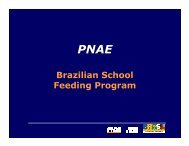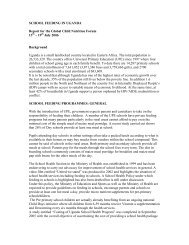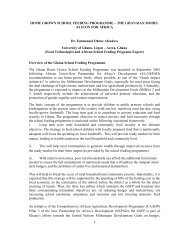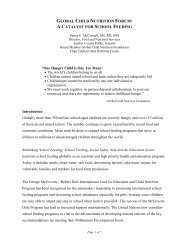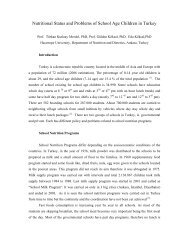EXECUTIVE SUMMARY - Global Child Nutrition Foundation
EXECUTIVE SUMMARY - Global Child Nutrition Foundation
EXECUTIVE SUMMARY - Global Child Nutrition Foundation
You also want an ePaper? Increase the reach of your titles
YUMPU automatically turns print PDFs into web optimized ePapers that Google loves.
The Ministry of Agriculture has programs to improve farmers’<br />
capacity so that schools have less difficulty accessing rations.<br />
Schools represent additional markets for farmers, which helps<br />
develop Kenya’s agricultural sector.<br />
The Ministry of Public Health’s interventions improve the<br />
health of children before they enter the school system, so they<br />
arrive ready to learn. The school feeding program helps raise<br />
the profile of nutrition as a cornerstone of health and<br />
development—a critical Ministry policy objective.<br />
The Ministry of Education’s policy goals are to improve<br />
education access, equity, and quality. The school feeding<br />
program keeps children in school, improving access; better<br />
nourishment allows for better concentration and learning<br />
retention, improving quality.<br />
Kenya’s home grown school feeding programs are<br />
improving health, educational, and economic conditions in<br />
the impoverished communities served.<br />
The Partnership for <strong>Child</strong> Development (PCD) conducted a case<br />
study and comparative analysis of Eradicating Hunger in Kenya<br />
using robust analytical methodology. Primary data was collected<br />
from surveys of community members, school officials, 4K club<br />
members, farmers, and others affected by the program;<br />
secondary data sources were used as well.<br />
Documented benefits of the program include:<br />
Increased school enrollment.<br />
Better nourished children.<br />
Parents who are more knowledgeable and educated about<br />
nutrition.<br />
Community empowerment, improved nutrition, higher<br />
household incomes.<br />
Community learning about food production and supply chain<br />
processes, including agricultural technology, food storage, and<br />
food distribution.<br />
Program sustainability. Schools and farmers are able to raise<br />
funds to continue the program when outside funding tapers off.<br />
Increased community awareness of nutritional indigenous<br />
foods that had been abandoned.<br />
The program faces challenges, however. Notably, Kenya<br />
experiences severe food supply shortages in regions with<br />
frequent droughts.<br />
Scaling Up Sustainability: Linking School Feeding with Agriculture<br />
Development to Maximize Food Security<br />
May 3-7, 2011<br />
Nairobi, Kenya<br />
© 2011 GCNF and PCD. All rights reserved. Page 12<br />
The study also noted the need for improved coordination of<br />
procurement and distribution processes and that this problem<br />
requires more government support. Another challenge noted was<br />
the lack of funding for scaling up the beneficial program.<br />
Among the best practices observed: Some farmers are joining<br />
together to sell their produce through one distributor. This allows<br />
schools to procure a variety of foods at less effort and expense.<br />
P4P is advancing the school feeding program’s success by<br />
helping to overcome food supply challenges.<br />
Purchase for Progress (P4P) is a five-year pilot project of the<br />
World Food Programme (WFP) that works to raise the proportion<br />
of food that WFP buys from smallholder farmers.<br />
By creating additional markets for smallholder farmers and by<br />
enabling them to get the training they need to solve business<br />
problems, P4P helps alleviate the food shortages that pose<br />
problems for Kenyan schools trying to procure local food. P4P<br />
was called “a strong partner of the government” in the Eradicate<br />
Hunger in Kenya effort. P4P has been operating in Kenya since<br />
2009.<br />
P4P’s model has three components:<br />
1) Using WFP’s purchasing power to promote economic<br />
development by helping farmers;<br />
2) Forming supply-side partnerships to ensure sufficient food<br />
supplies for WFP programs; and<br />
3) Sharing knowledge and training farmers in the agricultural and<br />
business skills they need to meet their challenges.<br />
Like PCD, P4P has identified challenges in the Kenya school<br />
feeding program, including:<br />
Lack of adequate food storage facilities.<br />
Climatic conditions that impede farmers’ ability to supply all<br />
of the food that WFP desires to buy.<br />
WFP’s procurement processes, which deter the participation<br />
of farmers who need immediate cash payment.<br />
Farmers who tend not to respect contracts for future delivery<br />
during times of rapidly rising food prices.<br />
Illiteracy, which prevents some farmers from reaping the P4Penabled<br />
opportunities.



